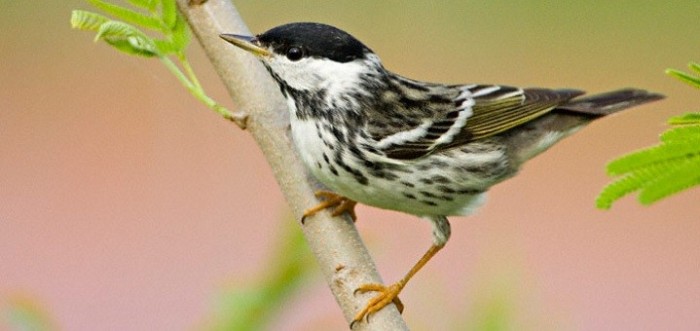
Blackpoll Warbler
Small creatures can indeed accomplish great feats. A recent research aimed to track the migration route of blackpoll warbler, a small songbird which weighs about 12g - 15g, equivalent to AA batteries.
Researchers from University of Guelph, Acadia University, Bird Studies Canada, the University of Massachusetts, the Vermont Centre for Ecostudies and the Smithsonian Conservation Biology Institute tracked the birds' flight by equipping them with tracking devices. They were attached to birds in Nova Scotia and Vermont in the summer. Researches also put coloured plastic bands for identification when they return. The geo-locators tracked the birds' flight path, but, because of their small size, they were not able to transmit the data remotely.
"We waited for them to return in the spring and then searched the forest to find the blackpolls with geo-locators," said William DeLuca, a research fellow at the University of Massachusetts, who led the Vermont part of the study.
Only 5 geo-locators were retrieved from nearly forty that was equipped to the birds the year before, 2013. But this is enough to prove that they use an ocean route during autumn. Every fall, most Blackpoll Warblers make an over-water migration from north-eastern coast to northern South America; some may pause in Bermuda or the Antilles,
but others apparently fly nonstop for more than 72 hours. In spring they are more leisurely, travelling via the West Indies and Florida, pausing to sing in shade trees on their way north.
Their research answered a long term debate on the bird's migration route.
It has been discovered that they undergo a 1700-mile journey over the Atlantic. Researchers claim that it's a fly-or-die journey without stopping or landing while flying along the east coast of the United States."This is the first study to provide direct evidence of the birds' migration route -
we found they flew directly over the Atlantic Ocean to reach their wintering grounds in South America," said Ryan Norris, a professor in Guelph's Department of Integrative Biology, who led the Canadian portion of the research.
There have been many indirect evidences about their migration route. This includes radar observation, stopovers at Bermuda, dead birds recovered from field sites and fatal obstacles. It is still unknown if they feed on insects while travelling.
"The indirect evidence in favour of an Atlantic voyage was fairly strong," Norris said.
"You have birds landing on ships in the Atlantic, radar studies off the tip of Nova Scotia showing the birds heading south, and very few sightings of blackpolls in the southern U.S. in the fall."
The blackpoll is common in the far northern forest during summer. Before migrating to South America for the winter, they spend summers in boreal forests stretching across North America.
"When we accessed the locators, we saw the blackpolls' journey was indeed directly over the Atlantic. The distances travelled ranged from 2,270 to 2,770 km," said DeLuca.
Each bird took 2 ½ to three days to make the trip. To prepare for the flight, they build up their fat stores, said Norris.
"These birds have a tremendous voyage ahead of them, with some likely flying from western Canada to the east coast before flying south. They eat as much as possible, in some cases doubling their body mass in fat so they can fly without needing food or water," he said.
"For blackpolls, they don't have the option of failing or coming up a bit short. It's a fly-or-die journey that requires so much energy."
The study was published in the Royal Society journal
Biology Letters.
Reader Comments
to our Newsletter